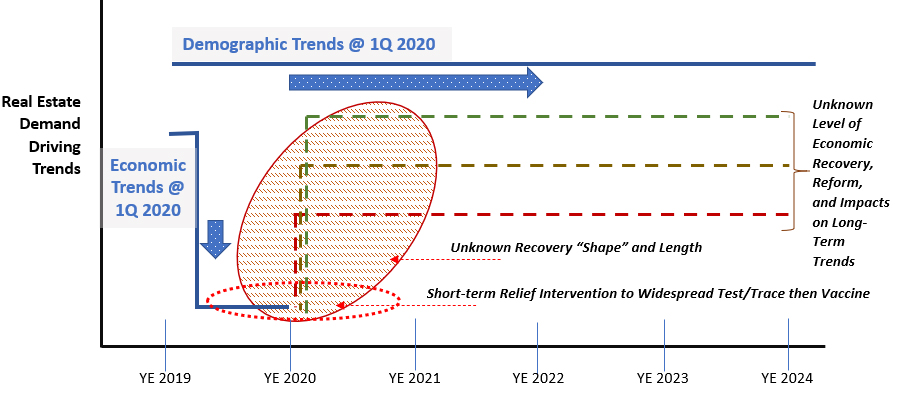
19 Apr KB Advisory Group assesses COVID-19 impacts on Atlanta Real Estate Market
At KB Advisory Group, we often find ourselves forecasting into the future. We are tasked with projecting employment and housing levels five- and ten-years out for small and large regions. Clients ask us to think about how many homes or square feet of commercial space might be market- or financially feasible at a single development, or county-wide, for example, over the next many years.
So, it goes-to-figure that folks would ask us where we thought things were heading with the economy and real estate markets during the Great Lockdown of the COVID-19 pandemic. Throughout April 2020, we were a bit reticent to formulate an answer as the future economic picture seems entirely dependent upon the unknown outcome of the public health conditions and the combined medical reaction to the virus. That is an area we cannot forecast, and we are not experts in tying public health outcomes to economic conditions. But we did a lot of thinking during our virtual office hours. Below is a diagram that summarizes our thinking about the potential for where we are heading in the Atlanta regional economy and real estate markets. What we are saying here is that two big catalysts drive real estate demand:
- Ever-shifting economic conditions, and
- Much more steady demographic trends.
The current demographic trends will persist throughout our current situation.

In April 2020, we were in the short-term relief-and-recovery mode for the economy. The time called for innovative and widespread public health and economic interventions. The interventions’ success would determine if the economic recovery is V-shaped, U-shaped, W-shaped, or, as someone said on a recent webinar, “bathtub shaped.”
The shape of the recovery and the interventions necessary for the survival of the real estate development industry and local governments, who together make up the bulk of our client roster, was very much fluid and continued the rest of 2020. We thought closely about the economic short-term (the next 12 months – through May of 2021) and planned to release our assessment of the depths to which the COVID-19 Great Lockdown will plunge the Atlanta retail market in an upcoming article.
We will continue to modify our opinion on the economy in the short-term as we observe the success of both the public health and economic relief and recovery interventions. The critical health strategies that need to be in place for the economy to recover from this unprecedented societal turmoil entirely are likely to be:
- Creation of widely available testing with quick reporting of results
- Development of a robust contact tracing and effective quarantine policies to quickly isolate the infected
- Identifying those who have developed antibodies from COVID-19 who can then go back to work, the creation of a mix of effective treatments for the most severely ill, and a vaccine that provides mass immunity from COVID-19
- Continued general isolation of the 65+ population and those with high-risk factors for a severe COVID-19 reaction
- The recovery of consumer attitudes that it is safe to return to work, retail, entertainment activities
These elements’ accomplishments will determine the length of time before economic and real estate markets return to “normal.”
However, we remain sure about some future real estate demand drivers and their impacts. These certainties can be found in our long-term demographic trends. While there are myriad interesting demographic trends that will persist over the next five years at least, we are thinking closely about those that will continue to drive housing demand through 2025.
Like the rest of the nation, the Atlanta region is in the midst of societal shifts in which household characteristics, transportation, communication, and lifestyles lead to transformative change in the operation of our economies and communities. These factors will still tremendously impact the housing and real estate markets in Atlanta. We wrote the following passages before the Great Lockdown, and we stand by them today:
Smaller, Non-Traditional Households are Ascending
Today’s households are trending smaller, with many more singles and “mingles,” fewer children present, and more empty nesters.
However, we remain certain about some future real estate demand drivers and their impacts. These certainties can be found in our long-term demographic trends. While there are myriad interesting demographic trends that will persist over the next five years at least, we are thinking closely about those that will continue to drive housing demand through 2025.
Like the rest of the nation, the Atlanta region is in the midst of societal shifts in which household characteristics, transportation, communication, and lifestyles are leading to transformative change in the operation of our economies and communities. These factors will still tremendously impact the housing and real estate markets in Atlanta. We wrote the following passages prior to the Great Lockdown and we stand by them today:
Smaller, Non-Traditional Households are Ascending
Today’s households are trending smaller, with many more singles and “mingles,” fewer children present, and more empty nesters. This has a profound impact on housing demand—security, low-maintenance, and convenience are replacing the desire for four bedrooms and a quality school system for a growing consumer segment. It results in a range of consumers seeking diverse housing types—rental apartments, for-sale condominiums, senior housing, multigenerational housing, accessory apartments, etc.—to match life-stage and household composition.
As the economy recovered from the economic shocks of the Great Recession nearly a decade ago, lifestyles of various generational cohorts shifted to accommodate the “new normal.” Younger households put off family formation and seeking housing to meet an active and often single lifestyle. Simultaneously, the retirement market has become more fluid, with many baby boomers and retirees choosing to be more conservative in their housing choices than before the recession.
Whatever shifts occur, they will not turn back the demographics. Current trends of additional smaller households living in more mixed-use settings will not go away. But there was also a countervailing trend emerging, one that saw Millennials having kids and becoming first-time homebuyers in the suburbs. That is likely to continue as well. They can both be true simultaneously; they were, and they will likely continue into the longer-term.
While we continue to monitor the short-term economic trends and their outcomes, we will also advocate for not losing sight of the long-term demographic trends and their sustained impact into the future.
This is resulting in a range of consumers seeking diverse housing types—rental apartments, for-sale condominiums, senior housing, multigenerational housing, accessory apartments, etc.,—to match life-stage and household composition.
As the economy recovered from the economic shocks of the Great Recession nearly a decade ago, lifestyles of various generational cohorts shifted to accommodate the “new normal.” Younger households put off family formation and seeking housing to meet an active, and often single lifestyle, while the retirement market has become more fluid, with many baby boomers and retirees choosing to be more conservative in their housing choices than prior to the recession.
Whatever shifts occur, they will not turn back the demographics. Current trends of additional smaller households living in more mixed-use settings will not go away. But there was also a countervailing trend emerging that saw Millennials having kids and becoming first-time homebuyers in the suburbs. That is likely to continue as well. They can both be true at the same time; they were, and they will likely continue into the longer-term.
While we continue to monitor the short-term economic trends and their outcomes, we will also advocate for not losing sight of the long-term demographic trends and their sustained impact into the future.
First published April 19, 2020


